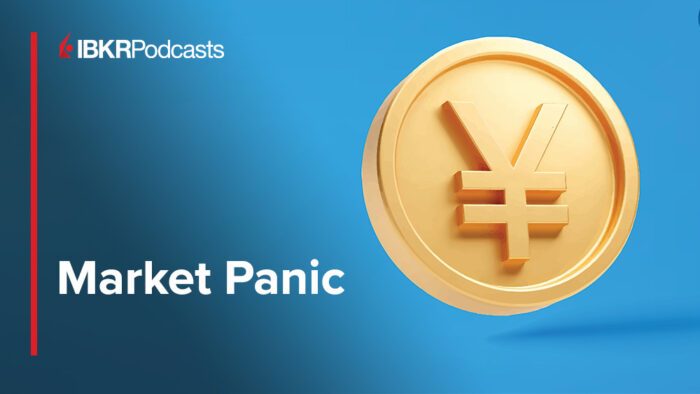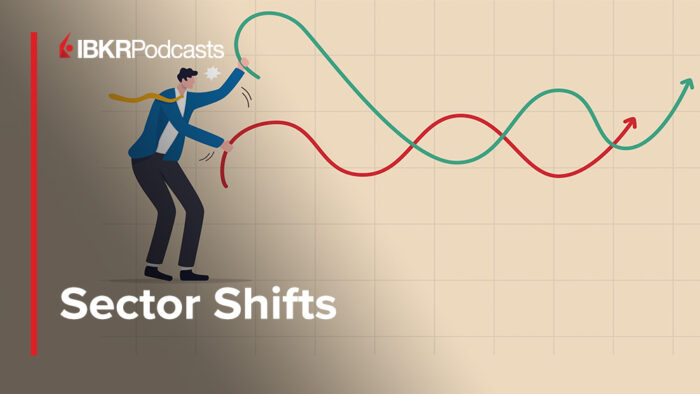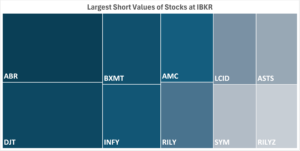Key takeaways
Global sell-off
Market corrections are not uncommon. The question is whether something larger is happening – i.e., a recession.
Recession fears
In my view, markets are overly worried about a US recession. I still believe the US job market is in relatively good shape.
Federal Reserve
I believe if the Fed starts to ease in September, it will likely be able to avoid a recession.
This week’s column comes in the wake of a sharp global market sell-off. On Monday, Japanese stocks set the stage with a 12.4% drop,1 and European stocks fell to a lesser extent, closing 2.2% lower.2 US markets tumbled, and the VIX volatility index briefly spiked above 60.3 What prompted this plunge, what should investors do now, and what indicators are we watching next?
The Fed held rates steady, and US economic data showed weakness
The US Federal Reserve (Fed) kept interest rates at current levels at its meeting on Wednesday (July 31) and declined to make a firm commitment to cut rates in September — although it left the door wide open to a rate cut. Markets took the news in stride on Wednesday, only to react negatively on Thursday and even more negatively on Friday in the face of some high-profile earnings misses and data indicating a weakening US economy:
- Initial jobless claims were worse than expected.
- The Manufacturing Purchasing Managers’ Index (PMI) for July fell to 46.8, which was below expectations, and the employment sub-index experienced a large drop to 43.4 from 49.3 in June.4
- The US employment situation report for July showed non-farm payroll gains were significantly lower than anticipated at 114,000 versus 175,000 expected.5 Payrolls for the previous two months were revised downward by 29,000.5 In addition, there was a significant increase in unemployment – from 4.1% to 4.3%.5 That means that we are now extremely close to the triggering of a recession indicator called the Sahm rule. The Sahm rule says that the early stages of a recession are signaled when the three-month moving average of the US unemployment rate is half a percentage point or more above the lowest three-month moving average unemployment rate over the previous 12 months. (Technically it hasn’t happened yet because the actual unemployment rate is 4.253%, which has been rounded up to 4.3%.)
The Bank of Japan and Bank of England took action
Unlike the Fed, other central banks took action last week.
The Bank of Japan (BOJ) made two important monetary policy decisions. First, it raised its key policy rate. Second, it decided to reduce its purchases of long-term Japanese Government Bonds (JGBs) by about 400 billion yen every quarter until March 2026 —which constitutes an implementation of a quantitative tightening (QT) policy. It’s important to note that the BOJ will conduct an interim assessment of the purchase plan and may modify the purchase amount if necessary.
Swayed by easing inflation data, the Bank of England (BOE) cut its policy rate by 25 basis points to 5.0%, its first rate cut since the pandemic and the first of this rate cycle. This should be a gradual easing cycle; the market is pricing a total of two rate cuts by the BOE this year. It’s important to note that while Consumer Price Index inflation has fallen to the BOE’s target of 2%, inflation forecasts from the BOE’s Monetary Policy Committee (MPC) were revised higher into year end (to 2.7%) to account for base effects of last year’s relative decline in energy prices. The BOE notes it expects second-round effects from domestic prices and wages to persist, but there is not a consensus on the duration of this within the members of the MPC.
The market sell-off: What can investors do now?
This all brings us to today – August 5. The double-digit drop in Japanese stocks does not come as a complete surprise given that the Japanese yen has strengthened so much. As we noted last week in the wake of the BOJ decision, there is a distinct risk that a strengthening yen will weaken Japanese stocks, as it has done over recent weeks and historically in the last several decades.6
On the other hand, I was surprised to see the VIX even briefly spiked above 60. To me, that suggests an overreaction.
So what is an investor to do?
First and foremost, stay calm. We have to remember that market corrections are not uncommon. They happen in most years and don’t tend to come out of nowhere. Our tactical indicator turned defensive at the start of July as growth was below trend and slowing. We’re not surprised to see bonds rallying and stocks falling. At midyear , we said we wouldn’t be surprised to see a correction (and then a recovery) before the end of the year.
The question is whether something larger is happening – i.e., a recession. We think markets are overly worried about recession. While we do believe that the Fed has increased recession risks by not cutting in July, we still believe the US job market is in relatively good shape and employers appear reluctant to cut employees. Having said that, markets have had a strong rally this year, suggesting very positive news is priced in, and so it makes sense that we are experiencing a meaningful correction given recent developments: a Fed that is more hawkish than expected, growing instability in the Middle East, some tech earnings disappointment, and increased uncertainty about the US presidential election. And of course markets are thinly traded in August.
But we also believe there are compelling reasons to be constructive about this sell-off:
Reasons for investors to be positive
Positive earnings surprises. Despite some high profile misses, earnings season has been relatively positive. Of the 75% of S&P 500 companies that have reported actual earnings results, 78% of them have reported a positive earnings-per-share (EPS) surprise and 59% of them have reported a positive revenue surprise.7
Third-quarter forecasts. More importantly, forecasts for earnings in the third quarter have not been downwardly revised beyond what is typical in the first month of the quarter. The bottom-up EPS estimate for the third quarter (which is an aggregate of median EPS estimates for all the companies in the S&P 500 index) decreased by 1.8% from June 30 to July 31.8 This decline is equal to the 5-year average, the 10-year average, and the 20-year average for S&P 500 companies; in all three of those time periods, earnings estimate were downwardly revised on average by 1.8%.8 And contributions to earnings growth have been broadening, with forward earnings projections indicating more contribution from non-Magnificent 7 companies.
Recession indicators have not been triggered. We don’t think risks of a recession have risen significantly. If you think about the key hallmarks of a recession, they have not been triggered:
- Lending standards for businesses, while still tight, have eased this year.9
- High yield spreads have widened but are still well below levels seen at the start of recessions.10 And Goldman Sachs has only increased its odds of a recession within the next year from 15% to 25%.11
- Nonfinancial corporate businesses continue to have low debt levels.12
- Although we have come close to triggering the Sahm rule, unemployment is still at very low levels relative to history. At 4.3%, the US is well below its long-term average unemployment rate of 5.69%.13
Fed rate cuts. We think it’s virtually a certainty that the Fed will cut rates before the end of the third quarter – and likely again in November and December. There is a growing probability of a 50 basis point rate cut in September and now there is a growing probability the Fed will cut before that meeting. (Markets even briefly anticipated today that the Fed would have to make an emergency cut before that meeting).14 We note that the July US jobs report also showed a drop in average hourly earnings to 3.6%15, indicating a continued reduction in wage inflation which should give the Fed more confidence to begin cutting.
Valuations. One key benefit of the sell-off is that valuations, which were admittedly very high, have already gotten more attractive.16 And there is a very significant amount of cash sitting on sidelines that investors are likely to deploy as bargains appear.
For those with a time horizon longer than a few months, I think it’s important to be patient. Yes, as I forewarned in last week’s blog, I believe it was a mistake that the Fed didn’t cut rates last week, but I don’t believe it will cause irreparable damage to the economy. This sell-off is a very emotional market reaction that is overestimating the potential for recession, in my view. We anticipate rate cuts are on the horizon, and we know the US economy is in relatively good shape.
Our base case is that it is not too late for the Fed to begin to cut. If the Fed does start to ease soon, we believe it will likely be able to avoid a recession, and the US economy would likely experience a re-acceleration in growth in late 2024/early 2025.
Outlook
I wouldn’t be surprised to experience a volatile and challenging market environment in coming weeks. However, I still worry that the biggest mistake long-term investors could make is getting spooked and moving out of markets. I have seen this emotional investor reaction occur in significant sell-offs over the years, including the Global Financial Crisis, and it is perhaps the most damaging decision investors can make. Rather, I am optimistic this sell-off could represent an opportunity for those patient investors with a significant overweighting to cash to consider reducing that exposure.
Looking ahead
The Jackson Hole conference begins in a few weeks. This is an opportunity for Fed policymakers to get closer to a commitment to cut rates – and also to articulate their views on the topic of R-star, which is the real long-term interest rate that is considered to be neutral — neither expansionary nor contractionary when the economy is at full employment. I think of this as a very arcane concept – one that can be considered “very imprecise” and subject to “considerable real-time mismeasurement”17 – but one that should give us a sense of where the Fed might be headed once it starts cutting rates.
With contributions from Paul Jackson, Tomo Kinoshita, Brian Levitt and Emma McHugh
Footnotes
1 Source: Bloomberg, as of Aug. 5, 2024. Base on the Nikkei 225 Index.
2 Source: CNBC, “Europe stocks close 2.2% lower amid global downturn as volatility index spikes to Covid-era high,” Aug. 5, 2024. Based on the Stoxx 600 Index.
3 Source: Bloomberg, as of Aug. 5, 2024
4 Source: S&P Global, July 31, 2024
5 Source: US Bureau of Labor Statistics, Aug. 2, 2024
6 Sources: Bank for International Settlements, MSCI, LSEG Datastream and Invesco. Based on the performance of the MSCI Japan Index versus the MSCI World Index, and the strength of the Japanese yen from January 1998 to Aug. 2, 2024.
7 Source: FactSet Earnings Insight, as of Aug, 2, 2024
8 Source: FactSet Earnings Insight.
9 Source: US Federal Reserve Bank Senior Loan Officer Survey, as of second quarter 2024.
10 Source: St. Louis Fed Economic Data, as of Aug. 5, 2024. The ICE BofA US High Yield Index Option-Adjusted Spread is currently at 3.72, which is well below levels seen at the start of the 2001 and 2007-2008 recessions as well as the 2020 recession.
11 Source: Bloomberg, “Goldman Economists Lift ‘Limited’ US Recession Risk to 25%,” Aug. 4, 2024
12 Source: US Federal Reserve as of Q124.
13 Source: US Bureau of Labor Statistics, based on the historical average from 1948-2024.
14 Source: Bloomberg, as of Aug. 2, 2024
15 Source: US Bureau of Labor Statistics, Aug, 2, 202415
16 Source: FactSet Research Systems. According to FactSet, the forward price-to-earnings ratio as of Aug. 2, 2024, was 20.7, compared to 21.2 as of July 19. Based on the S&P 500 Index.
17 Source: Federal Reserve Bank of New York
—
Originally Posted August 6, 2024
US recession fears prompt global market sell-off by Invesco US
Important information
The opinions referenced above are those of the author as of 5 August 2024.
This document is marketing material and is not intended as a recommendation to invest in any particular asset class, security or strategy. Regulatory requirements that require impartiality of investment/investment strategy recommendations are therefore not applicable nor are any prohibitions to trade before publication. The information provided is for illustrative purposes only, it should not be relied upon as recommendations to buy or sell securities.
Where individuals or the business have expressed opinions, they are based on current market conditions, they may differ from those of other investment professionals, they are subject to change without notice and are not to be construed as investment advice.The risks of investing in securities of foreign issuers, including emerging market issuers, can include fluctuations in foreign currencies, political and economic instability, and foreign taxation issues.
The risks of investing in securities of foreign issuers can include fluctuations in foreign currencies, political and economic instability, and foreign taxation issues.
Junk bonds involve a greater risk of default or price changes due to changes in the issuer’s credit quality. The values of junk bonds fluctuate more than those of high quality bonds and can decline significantly over short time periods.
The S&P 500® Index is an unmanaged index considered representative of the US stock market.The Nikkei 225 Index is a price-weighted average of 225 top-rated Japanese companies listed in the first section of the Tokyo Stock Exchange.
The STOXX® Europe 600 Index represents large-, mid-, and small-capitalization companies across 17 countries of the European region.The CBOE Volatility Index® (VIX®) is a key measure of market expectations of near-term volatility conveyed by S&P 500 Index option prices. VIX is the ticker symbol for the Chicago Board Options Exchange (CBOE) Volatility Index, which shows the market’s expectation of 30-day volatility.
Purchasing Managers’ Indexes (PMI) are based on monthly surveys of companies worldwide and gauge business conditions within the manufacturing and services sectors.
The Consumer Price Index (CPI) measures changes in consumer prices. Core CPI excludes food and energy prices, while headline CPI includes them.
The MSCI Japan Index measures the performance of the large- and mid-cap segments of the Japanese market.
The MSCI World Index is an unmanaged index considered representative of stocks of developed countries.The federal funds rate, or Fed Funds rate, is the rate at which US banks lend balances to each other overnight.Quantitative tightening (QT) is a monetary policy used by central banks to normalize balance sheets.
A basis point is one-hundredth of a percentage point.Base effects refers to a distortion in a monthly inflation figure that results from abnormal levels of inflation in the year-ago month.
The Magnificent Seven stocks refer to Amazon, Apple, Alphabet, Meta, Microsoft, Nvidia, and Tesla.Earnings per share (EPS) refers to a company’s total earnings divided by the number of outstanding shares.
Forward price-to-earnings ratio is calculated by dividing a company’s current share price by its expected earnings, usually for the next 12 months or the next full fiscal year.
Spread represents the difference between two values or asset returns.The Senior Loan Officer Survey is conducted by the US Federal Reserve to provide qualitative and limited quantitative information on bank credit availability and loan demand, as well as on evolving developments and lending practices in the US loan markets.
The ICE Bank of America US High Yield Index tracks the performance of US dollar-denominated, below-investment grade corporate debt publicly issued in the US domestic market.
Option-adjusted spread (OAS) is the yield spread that must be added to a benchmark yield curve to discount a security’s payments to match its market price, using a dynamic pricing model that accounts for embedded options.
EMEA3771124
Disclosure: Invesco US
This does not constitute a recommendation of any investment strategy or product for a particular investor. Investors should consult a financial advisor/financial consultant before making any investment decisions. Invesco does not provide tax advice. The tax information contained herein is general and is not exhaustive by nature. Federal and state tax laws are complex and constantly changing. Investors should always consult their own legal or tax professional for information concerning their individual situation. The opinions expressed are those of the authors, are based on current market conditions and are subject to change without notice. These opinions may differ from those of other Invesco investment professionals.
NOT FDIC INSURED
MAY LOSE VALUE
NO BANK GUARANTEE
All data provided by Invesco unless otherwise noted.
Invesco Distributors, Inc. is the US distributor for Invesco Ltd.’s Retail Products and Collective Trust Funds. Institutional Separate Accounts and Separately Managed Accounts are offered by affiliated investment advisers, which provide investment advisory services and do not sell securities. These firms, like Invesco Distributors, Inc., are indirect, wholly owned subsidiaries of Invesco Ltd.
©2024 Invesco Ltd. All rights reserved.
Disclosure: Interactive Brokers
Information posted on IBKR Campus that is provided by third-parties does NOT constitute a recommendation that you should contract for the services of that third party. Third-party participants who contribute to IBKR Campus are independent of Interactive Brokers and Interactive Brokers does not make any representations or warranties concerning the services offered, their past or future performance, or the accuracy of the information provided by the third party. Past performance is no guarantee of future results.
This material is from Invesco US and is being posted with its permission. The views expressed in this material are solely those of the author and/or Invesco US and Interactive Brokers is not endorsing or recommending any investment or trading discussed in the material. This material is not and should not be construed as an offer to buy or sell any security. It should not be construed as research or investment advice or a recommendation to buy, sell or hold any security or commodity. This material does not and is not intended to take into account the particular financial conditions, investment objectives or requirements of individual customers. Before acting on this material, you should consider whether it is suitable for your particular circumstances and, as necessary, seek professional advice.
Disclosure: Options (with multiple legs)
Options involve risk and are not suitable for all investors. For information on the uses and risks of options, you can obtain a copy of the Options Clearing Corporation risk disclosure document titled Characteristics and Risks of Standardized Options by clicking the link below. Multiple leg strategies, including spreads, will incur multiple transaction costs. "Characteristics and Risks of Standardized Options"































Join The Conversation
If you have a general question, it may already be covered in our FAQs. If you have an account-specific question or concern, please reach out to Client Services.